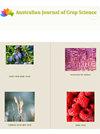Effect of salicylic acid in post-harvest quality of ‘BRS Kampai’ peaches submitted to different cold storage periods
Q3 Agricultural and Biological Sciences
引用次数: 2
Abstract
Fast ripening of fruits is one of the main hindrances to peach preservation. Even though the use of cold storage has extended commercialization periods, fruit quality is affected during storage. This study aimed at evaluating the influence of application of salicylic acid (SA) during cold storage, followed by commercialization simulation, regarding physical and chemical characteristics of ‘BRS Kampai’ peaches, which were harvested in the 2017 crop. The experiment was conducted in a completely randomized factorial design (4×3: SA concentrations × storage days), with four replications of ten fruits each. SA was applied at the following concentrations: 0, 2, 4 and 6 mM. Afterwards, fruits were submitted to cold storage at 1±0.5oC and 80-85% relative humidity. Analyses were carried out on harvest day, on the 10th cold storage day, followed by a day at room temperature (20oC) and on the 20th cold storage day, followed by a day at room temperature. Fruits were evaluated in terms of their mass loss, epidermis color, chromatic hue, pulp firmness, soluble solids (SS), pH and titratable acidity (TA). Both application of SA and cold storage contributed to decrease mass loss and TA, besides increasing the SS/TA relation. Fruits which were stored for 20 days and kept at room temperature for a day exhibited the highest values of SS and the lowest values of both brightness and pulp firmness. SA was efficient to maintain the quality of ‘BRS Kampai’ peaches submitted to cold storage for 10 and 20 days and an extra day of commercialization simulation.水杨酸对不同冷藏期‘BRS Kampai’桃采后品质的影响
果实早熟是桃保鲜的主要障碍之一。尽管使用冷藏延长了商业化周期,但水果的品质在储存过程中受到影响。本研究旨在评估水杨酸(SA)在冷藏期间的施用对2017年收获的“BRS Kampai”桃子物理和化学特性的影响,然后进行商业化模拟。试验采用完全随机因子设计(4×3: SA浓度×贮藏天数),4个重复,每个重复10个果实。分别以0、2、4和6 mM的浓度施用SA。之后,将果实置于1±0.5℃、80-85%相对湿度的冷库中。分别在收获日、冷藏第10天、室温(20℃)第1天、冷藏第20天、室温第1天进行分析。对果实的质量损失、表皮颜色、色相、果肉硬度、可溶性固形物(SS)、pH和可滴定酸度(TA)进行了评价。SA和冷库的应用均有助于降低质量损失和TA,并增加SS/TA关系。贮藏20 d、室温保存1 d的果实,其SS值最高,亮度和果肉硬度值最低。SA可以有效地保持‘BRS Kampai’桃子冷藏10天和20天以及额外一天的商业化模拟的质量。
本文章由计算机程序翻译,如有差异,请以英文原文为准。
求助全文
约1分钟内获得全文
求助全文
来源期刊

Australian Journal of Crop Science
农林科学-农艺学
CiteScore
1.20
自引率
0.00%
发文量
75
审稿时长
3.5 months
期刊介绍:
Information not localized
 求助内容:
求助内容: 应助结果提醒方式:
应助结果提醒方式:


